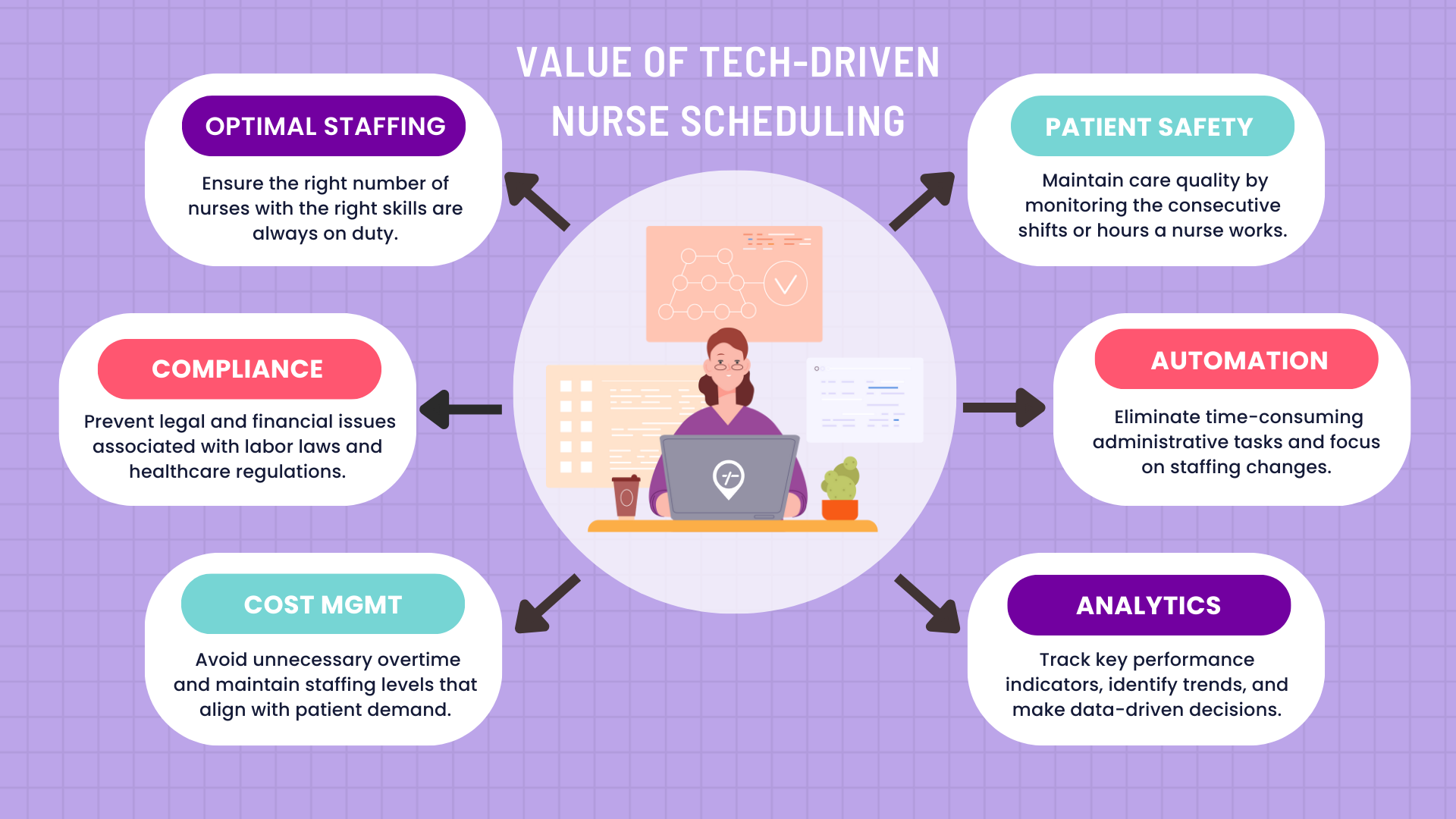A Comprehensive Guide to Healthcare Staffing Scheduling Software

In today's healthcare landscape, effective nurse scheduling is critical to maintain staff morale and ensure optimal patient care, especially with the added challenges posed by the staffing shortage and growing demand for job flexibility—not to mention many other factors that make proper staffing an intricate task.
To address these complexities adequately, investing in the right healthcare staffing scheduling software becomes a strategic imperative for skilled nursing facilities, hospitals, and health systems.
So, what should you consider when choosing the best scheduling software for your healthcare organization? You're about to find out.
Common Nurse Scheduling Problems
Healthcare staffing is a mess these days, with the nursing shortage putting facilities at risk and operational costs at an all-time high. Therefore, it’s critical to recognize the nurse scheduling problems that result in extensive overtime, nurse burnout, medical errors, inadequate staffing ratios, and more.
1. Unbalanced Workload Distribution
Addressing nursing staff shortages in healthcare facilities is a shared challenge, and relying on mandatory overtime and excessive consecutive shifts to fill staffing gaps is unsustainable and will eventually backfire.
Working too much overtime or consecutive hours can create physical and mental exhaustion among nurses, sparking a cycle of burnout and potential staff attrition. This, in turn, adversely affects nurse-patient ratios and compromises overall patient care quality. Beyond the human toll, the financial impact of skyrocketing overtime costs adds additional concern.
According to a 2019 European Review for Medical and Pharmacological Science study, nurses working rotating shifts or more than 12 hours at a time feel more tired and experience frequent burnout, resulting in them taking a leave of absence from the profession. Furthermore, nurses working over 12.5 consecutive hours in a shift are three times more likely to make a medication error.
The best nurse scheduling processes focus on distributing workloads fairly among staff while ensuring nurses have a balanced schedule.
2. Undervalued Nurse Scheduler Role
Nurse scheduling is a complex task akin to orchestrating a harmonious performance. Often undervalued, the nurse scheduler role is crucial for meeting organizational goals, ensuring compliance, and preventing operational inefficiencies.
So, when nurses double as schedulers—which they often do—and get pulled to the floor, facilities face incomplete schedules that can lead to unwanted overtime, inadequate staffing ratios, and other errors.
Not to mention, patient care often suffers when nurse managers handle scheduling and administrative tasks. According to a study published in the CIN Journal, nursing management impacts care outcomes, needing as much time as possible to focus on tasks that improve hospital care—yet some nurse managers say they spend up to 49% of their work time on deskwork.
Furthermore, the critical importance of nurse scheduling is underscored by the need for advance posting, ideally four to six weeks ahead. However, nurses juggling dual roles can become too busy to keep tabs on this essential practice, resulting in dormant schedules that get posted at the last minute and yield unnecessary challenges.
Ensuring timely schedule publication enhances organizational efficiency and improves nurses' work-life balance, fostering a more sustainable and harmonious healthcare environment.
Dedicated nurse schedulers equipped with proper training and technology are pivotal in establishing strategic, cost-effective facility staffing processes. They can enhance operational efficiency and create a better work-life balance for nurses via well-planned schedules posted promptly—ultimately fostering a more sustainable and harmonious healthcare environment.
3. Time-Consuming Manual Tasks
With proper technology, nurse schedulers can avoid the burden of manual, time-consuming administrative tasks that lead to inefficiencies and increased errors. For example, manual work on spreadsheets can result in missed shifts, low productivity, and inaccurate data.
However, with the right technology, schedulers can automate tedious manual tasks, reducing scheduling errors and allowing more time to focus on the well-being of nurses and patients, such as addressing last-minute staffing changes and fluctuating demand.
Investing in technology saves time and is a strategic move toward fostering a more effective and error-resistant healthcare scheduling process.

How Nurse Scheduling Software Promotes Operational Excellence
Nurse scheduling software or healthcare scheduling software contributes significantly to operational excellence in skilled nursing facilities, hospitals, and health systems by optimizing and streamlining various aspects of workforce management.
Scheduling software contributes to:
Efficient staffing by creating schedules that focus on nurse availability, skills, and preferences.
Reduced overtime by monitoring work hours and overtime regulations.
Improved compliance by keeping tabs on labor laws, union rules, and internal policies.
Enhanced communication by quickly disseminating critical information among staff members.
Employee satisfaction by facilitating flexibility and promoting a fair distribution of shifts.
Data-driven decisions by providing valuable insight into staffing patterns and workload distribution.
Time and resource savings by automating administrative scheduling tasks.
Healthcare Scheduling Software Comparison
Selecting the optimal healthcare scheduling software is crucial for the smooth operation of any healthcare organization. To make a sound and compelling decision, consider the following key factors:
User-Friendly Interface: Look for software with an intuitive interface that's easy for staff and administrators to navigate—ease of use facilitates quick adoption and helps reduce training time.
Customization Options: Ensure you can customize the software to meet your healthcare organization's specific needs and workflows—flexibility is essential for adapting to changing requirements.
Integration Capabilities: Choose software that seamlessly integrates with other systems used in your organization, such as vendor management systems, managed service providers, and workforce management platforms.
Comprehensive Features: Evaluate the scheduling features offered, including shift planning, automated scheduling, and real-time updates. The software should support various scheduling methods to accommodate different departments and roles.
Mobile Accessibility: Look for a solution that provides mobile accessibility, allowing staff to access schedules, make changes, and communicate with colleagues for improved responsiveness.
Compliance and Security: Ensure that the software complies with healthcare regulations, prioritizes security and data protection, and ensures patient confidentiality.
Analytics and Reporting: Look for software with robust analytics and reporting capabilities that help track key performance indicators, identify trends, and enable data-driven decisions for better resource allocation.
Scalability and Future-Proofing: Choose software that can scale with the growth of your organization, which is crucial for long-term viability and prevents the need for frequent system upgrades.
Cost-Effectiveness: Consider the overall cost of ownership, including licensing fees, implementation, and maintenance costs. Ensure that the software provides value for money and aligns with your budget constraints.
Vendor Support: Assess the level of support and training provided by the software vendor. A responsive support team and comprehensive training resources contribute to successful implementation and ongoing use.

ShiftMed On-Demand Staffing Platform
ShiftMed is a comprehensive workforce solutions partner that redefines how nurses and healthcare facilities collaborate to provide continuous, high-quality patient care.
We seamlessly link credentialed CNAs, LPNs, and RNs seeking job flexibility with skilled nursing facilities, hospitals, and health systems needing to fill open shifts on demand.
And we offer more than just healthcare staffing scheduling software. We're the whole workforce kit and kaboodle, offering a robust fusion of human capital, advanced tools, and innovative technology to help your organization thrive in today's dynamic healthcare arena.
Our technology-driven solutions simplify shift fulfillment and maintain patient care continuity—all while saving you time and money on staffing.
Workforce Marketplace
Our healthcare workforce marketplace provides direct access to local, credentialed nurses, from CNAs to specialty RNs, to fill your shifts on demand. You can scale your workforce up or down based on patient volume and acuity, preventing understaffing or overstaffing.
Beyond filling staffing gaps, our marketplace also serves as a bridge-to-hire solution. It lets you nurture potential candidates and seamlessly transition them to permanent positions, saving you from high recruitment costs.
Every nurse in our marketplace is a W-2 employee, a classification that helps protect your organization from legal and financial risks.
Credentialing System
Every nurse in our workforce marketplace undergoes rigorous vetting to ensure they have the proper licensure and requisite skills that align with the ethos of patient-centered care.
We adhere to all federal, state, and local regulatory standards for professional practice. We can customize our credentialing process to meet your organization's unique staffing requirements, from orientation shifts to drug testing.
Furthermore, we ensure our healthcare professionals remain current on their credentials so you can stay ahead of evolving industry standards and regulatory changes.
ShiftMed API
Our API makes it easy for your vendor management system, managed service provider, or workforce management platform to tap into our healthcare workforce marketplace for fast, on-demand shift fulfillment.
Furthermore, our API enables you to centralize your internal and external labor pool data for efficient, streamlined staffing operations. Clean, consolidated data reduces manual efforts and improves reporting and invoice accuracy.
Internal Resource Manager
Our internal resource manager supercharges your workforce efficacy and savings via predictive analytics and business intelligence.
AI-powered resources make identifying your most critical staffing needs easy, so you can use the most cost-effective resources to rebalance your full-time equivalents (FTEs) and labor pools.
Real-time staffing information helps your organization make strategic, data-driven decisions to optimize resource allocation and enhance patient safety.
Task automation boosts scheduling efficiency and reduces unnecessary administrative tasks for workforce productivity.
Gap Shift Management Technology
This technology is a powerful combination of ShiftMed products that reduces agency dependency, minimizes overtime costs, and optimizes HPPD goals. More specifically, you have unparalleled control over your workforce. You can establish agile internal resource pools, simplify your nurse scheduling processes, automate communication, and streamline the sourcing and management of your contract labor.
Best Healthcare Workforce Management Software
U.S. News & World Report named ShiftMed the best healthcare workforce management software of 2024, stating that what makes us unique is our ability to fill any scheduling gaps at any healthcare organization with our credentialed, qualified nursing staff.
Conclusion
Navigating today's intricate healthcare staffing landscape demands a strategic approach, especially given the ongoing staffing shortage and increased demand for job flexibility. The approach requires recognizing the critical role nurse scheduling plays in maintaining staff morale, reducing labor costs, and ensuring optimal patient care—making it paramount to invest in the right healthcare staffing scheduling software for your organization.
Learn how ShiftMed can help elevate your organization to the pinnacle of healthcare excellence; schedule a free demo today!